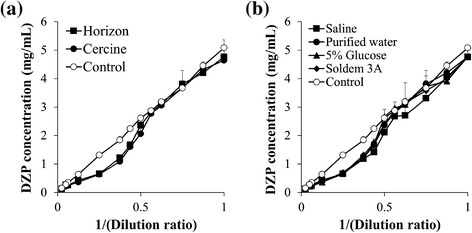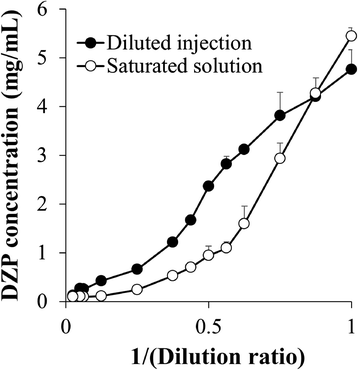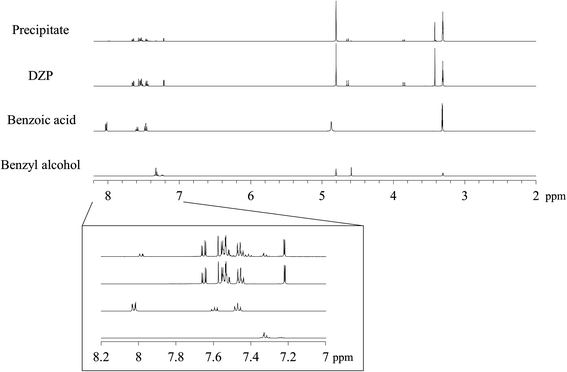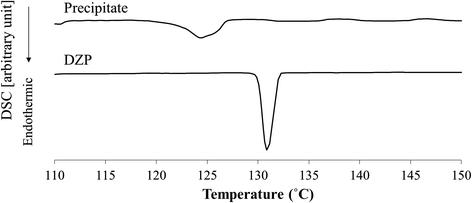Supersaturated state of diazepam injection following dilution with infusion fluid
- PMID: 26819720
- PMCID: PMC4728752
- DOI: 10.1186/s40780-014-0009-9
Supersaturated state of diazepam injection following dilution with infusion fluid
Abstract
Background: Significant precipitation produced by the dilution of diazepam (DZP) injection with an infusion fluid is a great concern for the clinical practice. In this study, the precipitation behavior under different conditions was investigated.
Method: For the sample preparation, DZP injections (Horizon injection and Cercine injection) were diluted with various infusion fluids (Saline, 5% glucose infusion fluid and Soldem 3A) at designated dilution ratios ranging from 1× to 40× (5 mg/mL to 0.125 mg/mL). In addition, to measure the solubility of DZP in the samples, the saturated solutions of DZP were prepared. The DZP concentrations in the samples were measured by high-performance liquid chromatography (HPLC). This study also investigated the precipitate using various analytical methods: infrared microscopy, (1)H-NMR, differential scanning calorimetry, and powder X-ray deflection.
Results: First, the compatibility of injection with infusion fluids was investigated. Significant precipitation occurred at dilution ratios ranging from 2× to 20×. No significant effects of formulations and infusion fluids on the compatibility were observed. The solubility of DZP was then further investigated. The concentration of DZP dissolved in the admixtures was higher than the solubility. This indicated that DZP existed in a supersaturated state in the infusion fluid admixtures. In the next phase of this study, the precipitate was investigated using various analytical methods. Results showed that the precipitate in infusion fluid admixtures was mostly composed of DZP, but also contained small amounts of the ingredients of DZP injection, such as benzoic acid and benzyl alcohol.
Conclusions: This study clarified details of the precipitation occurring after dilution of DZP injection with infusion fluids. It is worth noting that DZP in an infusion admixture existed in a supersaturated state. These findings offer important insight into the clinical practice of DZP injection.
Keywords: 1H-NMR; Diazepam injection; IR microscopy; Infusion fluids; Precipitation; Supersaturated state.
Figures






Similar articles
-
Conversion of a soluble diazepam prodrug to supersaturated diazepam for rapid intranasal delivery: Kinetics and stability.J Control Release. 2018 Nov 10;289:1-9. doi: 10.1016/j.jconrel.2018.09.013. Epub 2018 Sep 15. J Control Release. 2018. PMID: 30227158
-
Diazepam: intravenous infusion in the treatment of status epilepticus.Acta Neurol Scand. 1976 Sep;54(3):278-80. doi: 10.1111/j.1600-0404.1976.tb04804.x. Acta Neurol Scand. 1976. PMID: 961379
-
Compatibility and stability of diazepam injection following dilution with intravenous fluids.Am J Hosp Pharm. 1978 Jun;35(6):669-72. Am J Hosp Pharm. 1978. PMID: 665679
-
Enhanced permeation of diazepam through artificial membranes from supersaturated solutions.J Pharm Sci. 2006 Apr;95(4):896-905. doi: 10.1002/jps.20600. J Pharm Sci. 2006. PMID: 16493587
-
A 5% glucose infusion fluid provokes significant precipitation of phenytoin sodium injection via interruption of the cosolvent effect of propylene glycol.Chem Pharm Bull (Tokyo). 2012;60(1):86-93. doi: 10.1248/cpb.60.86. Chem Pharm Bull (Tokyo). 2012. PMID: 22223379
Cited by
-
Incompatibility of remimazolam besylate with Ringer's acetate infusion resulting in total occlusion of an intravenous catheter.BMJ Case Rep. 2021 Apr 15;14(4):e241622. doi: 10.1136/bcr-2021-241622. BMJ Case Rep. 2021. PMID: 33858900 Free PMC article.
-
Intentional Hydroxychloroquine Overdose Treated with High-Dose Diazepam: an Increasing Concern in the COVID-19 Pandemic.J Med Toxicol. 2020 Jul;16(3):314-320. doi: 10.1007/s13181-020-00790-8. Epub 2020 Jun 8. J Med Toxicol. 2020. PMID: 32514696 Free PMC article.
References
-
- Morris ME. Compatibility and stability of diazepam injection following dilution with intravenous fluids. Am J Hosp Pharm. 1978;35:669–672. - PubMed
-
- Tehrani JB, Cavanaugh A. Diazepam infusion in the treatment of tetanus. Drug Intell Clin Pharm. 1977;11:491.
-
- Baxter MT, McKenzie DD, Mikish RA. Dilution of diazepam in intravenous fluids. Am J Hosp Pharm. 1977;34:124. - PubMed
-
- Korttila K, Sothman A, Andersson P. Polyethylene glycol as a solvent for diazepam: bioavailability and clinical effects after intramuscular administration, comparison of oral, intramuscular and rectal administration, and precipitation from intravenous solutions. Acta Pharmacol Toxicol. 1976;39:104–117. doi: 10.1111/j.1600-0773.1976.tb03161.x. - DOI - PubMed
LinkOut - more resources
Full Text Sources
Other Literature Sources

